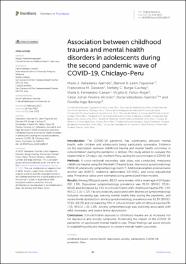Mostrar el registro sencillo del ítem
Association between childhood trauma and mental health disorders in adolescents during the second pandemic wave of COVID-19, Chiclayo-Peru
| dc.contributor.author | Valladares-Garrido, Mario J. | |
| dc.contributor.author | León-Figueroa, Darwin A. | |
| dc.contributor.author | Dawson, Franccesca M. | |
| dc.contributor.author | Burga-Cachay, Stefany C. | |
| dc.contributor.author | Fernandez-Canani, Maria A. | |
| dc.contributor.author | Failoc-Rojas, Virgilio E. | |
| dc.contributor.author | Pereira-Victorio, César Johan | |
| dc.contributor.author | Valladares-Garrido, Danai | |
| dc.contributor.author | Inga-Berrospi, Fiorella | |
| dc.date.accessioned | 2023-10-10T18:48:14Z | |
| dc.date.available | 2023-10-10T18:48:14Z | |
| dc.date.issued | 2023-06-22 | |
| dc.identifier.uri | https://hdl.handle.net/20.500.13053/9527 | |
| dc.description.abstract | Introduction: The COVID-19 pandemic has significantly affected mental health, with children and adolescents being particularly vulnerable. Evidence on the association between childhood trauma and mental health outcomes in schoolchildren during the pandemic is limited. This study aimed to evaluate this relationship in Chiclayo city, northern Peru, during the second wave of COVID-19. Methods: A cross-sectional secondary data study was conducted, measuring childhood trauma using the Marshall’s Trauma Scale, depressive symptomatology (PHQ-9), and anxiety symptomatology (GAD-7). Additional variables assessed were alcohol use (AUDIT), resilience (abbreviated CD-RISC), and socio-educational data. Prevalence ratios were estimated using generalized linear models. Results: Among 456 participants, 88.2% were female, with a mean age of 14.5 years (SD: 1.33). Depressive symptomatology prevalence was 76.3% (95%CI: 72.14– 80.15) and increased by 23% in schoolchildren with childhood trauma (PR: 1.23; 95%CI: 1.10–1.37). Factors positively associated with depressive symptomatology included increasing age, seeking mental health help during the pandemic, and severe family dysfunction. Anxiety symptomatology prevalence was 62.3% (95%CI: 57.65–66.75) and increased by 55% in schoolchildren with childhood trauma (PR: 1.55; 95%CI: 1.31–1.85). Anxiety symptomatology was positively associated with mild, moderate, and severe family dysfunction. Conclusion: Schoolchildren exposed to childhood trauma are at increased risk for depressive and anxiety symptoms. Monitoring the impact of the COVID-19 pandemic on adolescent mental health is vital. These findings can assist schools in establishing effective measures to prevent mental health outcomes. | es_PE |
| dc.format | application/pdf | es_PE |
| dc.language.iso | eng | es_PE |
| dc.publisher | FRONTIERS MEDIA SA | es_PE |
| dc.rights | info:eu-repo/semantics/openAccess | es_PE |
| dc.rights.uri | https://creativecommons.org/licenses/by/4.0/ | es_PE |
| dc.subject | childhood trauma, mental health, depression, anxiety, adolescents, COVID-19, pandemic, Peru | es_PE |
| dc.title | Association between childhood trauma and mental health disorders in adolescents during the second pandemic wave of COVID-19, Chiclayo-Peru | es_PE |
| dc.type | info:eu-repo/semantics/article | es_PE |
| dc.identifier.doi | 10.3389/fpsyt.2023.1169247 | |
| dc.type.version | info:eu-repo/semantics/publishedVersion | es_PE |
| dc.publisher.country | CHE | es_PE |
| dc.subject.ocde | 3.03.00 -- Ciencias de la salud | es_PE |
Ficheros en el ítem
Este ítem aparece en la(s) siguiente(s) colección(es)
-
Web of Science (WOS) [236]


